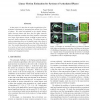Free Online Productivity Tools
i2Speak
i2Symbol
i2OCR
iTex2Img
iWeb2Print
iWeb2Shot
i2Type
iPdf2Split
iPdf2Merge
i2Bopomofo
i2Arabic
i2Style
i2Image
i2PDF
iLatex2Rtf
Sci2ools
CVPR
2008
IEEE
2008
IEEE
Linear motion estimation for systems of articulated planes
In this paper, we describe the explicit application of articulation constraints for estimating the motion of a system of planes. We relate articulations to the relative homography between planes and show that for affine cameras, these articulations translate into linear equality constraints on a linear least squares system, yielding accurate and numerically stable estimates of motion. The global nature of motion estimation allows us to handle areas where there is limited texture information and areas that leave the field of view. Our results demonstrate the accuracy of the algorithm in a variety of cases such as human body tracking, motion estimation of rigid, piecewise planar scenes and motion estimation of triangulated meshes.
Articulation Constraints | Computer Vision | CVPR 2008 | Limited Texture Information | Linear Equality Constraints | Motion Estimation | Piecewise Planar Scenes |
| Added | 12 Oct 2009 |
| Updated | 12 Oct 2009 |
| Type | Conference |
| Year | 2008 |
| Where | CVPR |
| Authors | Ankur Datta, Yaser Sheikh, Takeo Kanade |
Comments (0)

